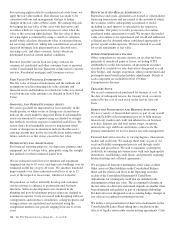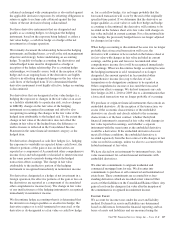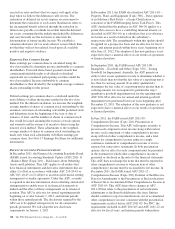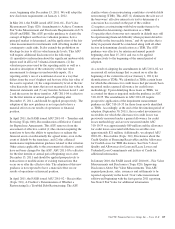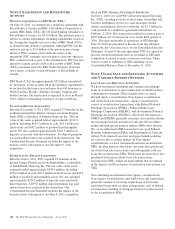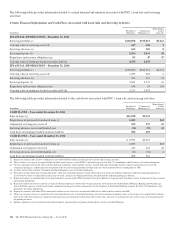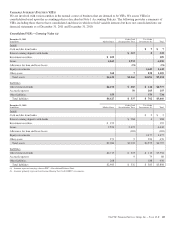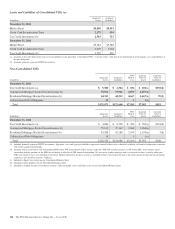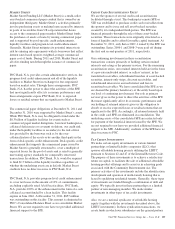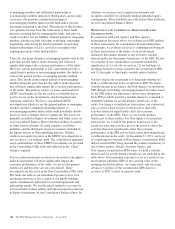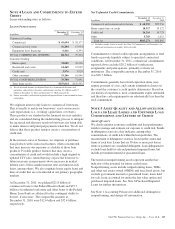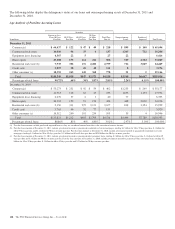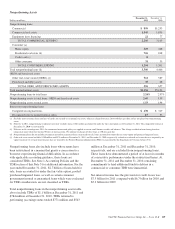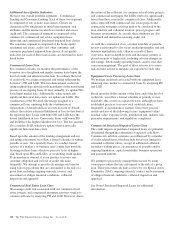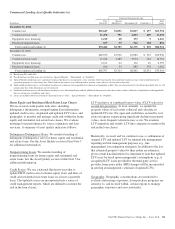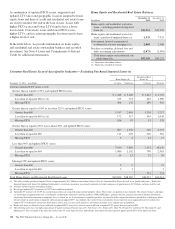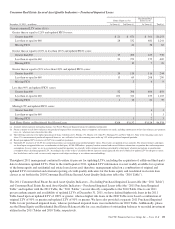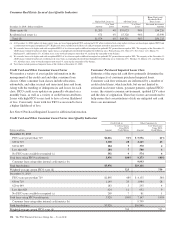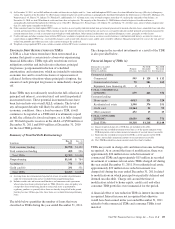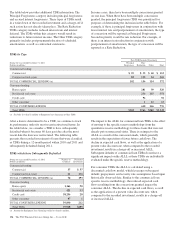PNC Bank 2011 Annual Report Download - page 135
Download and view the complete annual report
Please find page 135 of the 2011 PNC Bank annual report below. You can navigate through the pages in the report by either clicking on the pages listed below, or by using the keyword search tool below to find specific information within the annual report.or managing member and sell limited partnership or
non-managing member interests to third parties, and in some
cases may also purchase a limited partnership or
non-managing member interest in the fund and/or provide
mezzanine financing to the fund. The purpose of this business
is to generate income from the syndication of these funds,
generate servicing fees by managing the funds, and earn tax
credits to reduce our tax liability. General partner or managing
member activities include selecting, evaluating, structuring,
negotiating, and closing the fund investments in operating
limited partnerships or LLCs, as well as oversight of the
ongoing operations of the fund portfolio.
Typically, the general partner or managing member will be the
party that has the right to make decisions that will most
significantly impact the economic performance of the entity.
However, certain partnership or LLC agreements provide a
single limited partner or non-managing member the ability to
remove the general partner or managing member without
cause. This results in the limited partner or non-managing
member being the party that has the right to make decisions
that will most significantly impact the economic performance
of the entity. The primary sources of losses and benefits in
LIHTC investments are the tax credits, tax benefits due to
passive losses on the investments, and development and
operating cash flows. We have consolidated LIHTC
investments in which we are the general partner or managing
member and have a limited partnership interest or
non-managing member interest that could potentially absorb
losses or receive benefits that are significant. The assets are
primarily included in Equity investments and Other assets on
our Consolidated Balance Sheet with the liabilities classified
in Other borrowed funds, Accrued expenses, and Other
liabilities and the third-party investors’ interests included in
the Equity section as Noncontrolling interests. Neither
creditors nor equity investors in the LIHTC investments have
any recourse to our general credit. The consolidated aggregate
assets and liabilities of these LIHTC investments are provided
in the Consolidated VIEs table and reflected in the “Other”
business segment.
For tax credit investments in which we do not have the right to
make decisions that will most significantly impact the
economic performance of the entity, we are not the primary
beneficiary and thus they are not consolidated. These
investments are disclosed in the Non-Consolidated VIEs table.
The table also reflects our maximum exposure to loss. Our
maximum exposure to loss is equal to our legally binding
equity commitments adjusted for recorded impairment and
partnership results. We use the equity method to account for
our investment in these entities with the investments reflected
in Equity investments on our Consolidated Balance Sheet. In
addition, we increase our recognized investments and
recognize a liability for all legally binding unfunded equity
commitments. These liabilities are reflected in Other liabilities
on our Consolidated Balance Sheet.
R
ESIDENTIAL AND
C
OMMERCIAL
M
ORTGAGE
-B
ACKED
S
ECURITIZATIONS
In connection with each Agency and Non-Agency
securitization discussed above, we evaluate each SPE utilized
in these transactions for consolidation. In performing these
assessments, we evaluate our level of continuing involvement
in these transactions as the nature of our involvement
ultimately determines whether or not we hold a variable
interest and/or are the primary beneficiary of the SPE. Factors
we consider in our consolidation assessment include the
significance of (1) our role as servicer, (2) our holdings of
mortgage-backed securities issued by the securitization SPE,
and (3) the rights of third-party variable interest holders.
Our first step in our assessment is to determine whether we
hold a variable interest in the securitization SPE. We hold a
variable interest in an Agency and Non-Agency securitization
SPE through our holding of mortgage-backed securities issued
by the SPE and/or our repurchase and recourse obligations.
Each SPE in which we hold a variable interest is evaluated to
determine whether we are the primary beneficiary of the
entity. For Agency securitization transactions, our contractual
role as servicer does not give us the power to direct the
activities that most significantly affect the economic
performance of the SPEs. Thus, we are not the primary
beneficiary of these entities. For Non-Agency securitization
transactions, we would be the primary beneficiary to the
extent our servicing activities give us the power to direct the
activities that most significantly affect the economic
performance of the SPE and we hold a more than insignificant
variable interest in the entity. At December 31, 2011, our level
of continuing involvement in Non-Agency securitization SPEs
did not result in PNC being deemed the primary beneficiary of
any of these entities. Details about the Agency and
Non-Agency securitization SPEs where we hold a variable
interest and are not the primary beneficiary are included in the
table above. Our maximum exposure to loss as a result of our
involvement with these SPEs is the carrying value of the
mortgage-backed securities, servicing assets, and servicing
advances. Creditors of the securitization SPEs have no
recourse to PNC’s assets or general credit.
126 The PNC Financial Services Group, Inc. – Form 10-K


